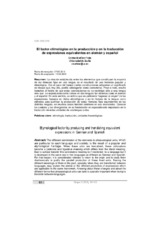Mostrar el registro sencillo del ítem
El factor etimológico en la producción y en la traducción de expresiones equivalentes en alemán y español
| dc.contributor.author | Martínez Fraile, Cristina | |
| dc.date.accessioned | 2018-02-12T10:30:56Z | |
| dc.date.available | 2018-02-12T10:30:56Z | |
| dc.date.issued | 2013 | |
| dc.identifier.issn | 2255-3703 | |
| dc.identifier.uri | http://hdl.handle.net/10396/16132 | |
| dc.description.abstract | La relación establecida entre los elementos que constituyen la mayoría de las fórmulas fijas en una lengua es el resultado de una herencia popular y etimológica. Con el paso del tiempo ciertas construcciones adquieren un significado en bloque que, hoy día, podría catalogarse como connotativo. Pese a todo, resulta llamativo el hecho de que estas connotaciones no se restrinjan sólo a una lengua sino que se reproduzcan como calcos en dos lenguas tan distintas como el alemán y el español. En este sentido, se estima que es pertinente “regresar al origen” de las expresiones, basarse en datos etimológicos y en la historia de la lengua como métodos para justificar la producción de estas fórmulas fijas equivalentes en las distintas lenguas, en muchos casos también similares en sus enunciados. Conocer los cambios y las divergencias en su formulación es especialmente importante en la traducción de estas unidades de una lengua a otra. | es_ES |
| dc.description.abstract | The different combination of the elements in phraseological units, which are particular to each language and society, is the result of a popular and etymological heritage. When these units are lexicalized, these collocations become a particular and figurative meaning which differs from the literal meaning. Due to cultural transfer this connotative meaning isn´t restricted to a language but it is developed in the same way in two languages as different as German and Spanish. For that reason, it is considerated relevant to return to the origin and to study them diachronically to justify the paralell production of these fixed units. Tracing the different meanings of them in the past, specially when they are transferred between languages, may explain the similar or the different production of expressions which are applicable to the same framework. Knowing about these changes and about the different forms that phraseological units can take is specially important when trying to translate between languages. | es_ES |
| dc.format.mimetype | application/pdf | es_ES |
| dc.language.iso | spa | es_ES |
| dc.publisher | UCOPress | es_ES |
| dc.rights | https://creativecommons.org/licenses/by/3.0/ | es_ES |
| dc.source | Skopos 3, 101-122 (2013) | es_ES |
| dc.subject | Etimología | es_ES |
| dc.subject | Traducción | es_ES |
| dc.subject | Unidades fraseológicas | es_ES |
| dc.subject | Etymology | es_ES |
| dc.subject | Translation | es_ES |
| dc.subject | Phraseological units | es_ES |
| dc.title | El factor etimológico en la producción y en la traducción de expresiones equivalentes en alemán y español | es_ES |
| dc.title.alternative | Etymological factor by producing and translating equivalent expressions in German and Spanish | en |
| dc.type | info:eu-repo/semantics/article | es_ES |
| dc.relation.publisherversion | https://www.uco.es/ucopress/ojs/index.php/skopos/index | es_ES |
| dc.rights.accessRights | info:eu-repo/semantics/openAccess | es_ES |

